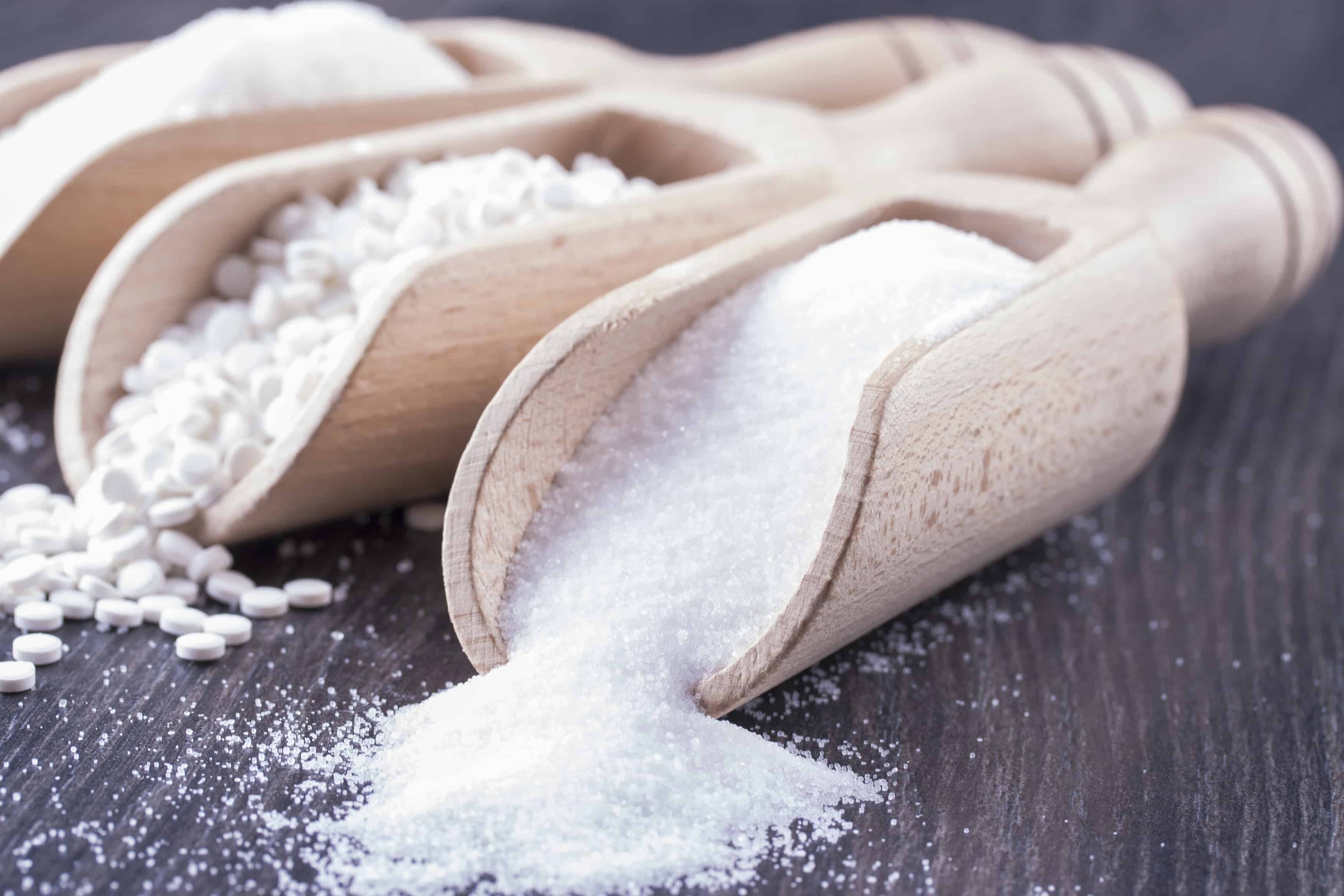
We sat down with Robyn Flipse, a registered dietitian specializing in food, nutrition and health communications, to talk about aspartame and debunk many of the myths that surround this extensively researched low calorie sweetener.
Robyn has over 25 years of experience and has written two books, The Wedding Dress Diet and Fighting the Freshman Fifteen. You can catch up with her on Twitter and Facebook.
What’s the difference between white table sugar and all of those substitutes in the colored packets?
The one thing all sweeteners have in common is their ability to make foods, beverages and even medicines taste better. Most of us would not eat yogurt, drink coffee or swallow cough syrup if they weren’t sweetened a bit. When sugar is used, it supplies 16 calories per teaspoon. The different sweetening ingredients in those packets provide few or no calories, yet deliver the sweetening power of 2 teaspoons of sugar per packet.
Are all sugar substitutes basically the same?
There are currently 7 different low calorie sweeteners approved for use in the U.S. They are acesulfame potassium, aspartame, neotame, monk fruit extract, saccharin, stevia and sucralose. Each one is different), just as white table sugar, honey and high fructose corn syrup are different types of caloric sweeteners.
Why are there so many different low-calorie sweeteners?
If you like maple syrup on your pancakes and brown sugar in your cookie dough, then you know that some caloric sweeteners are better suited for some jobs than others. The same is true for low calorie sweeteners. For example, aspartame provides a fresh, crisp taste to sparkling beverages, while sucralose performs well in jams and syrups that must be heated for long periods of time.
Why is there more than one low calorie sweetener in many sugar free foods and drinks?
By blending different low calorie sweeteners, food and beverage companies have found they can create a taste profile in their low calorie and diet products that comes closest to the taste of their full calorie ones. They also combine low calorie sweeteners with sugar and other caloric sweeteners to create reduced calorie and light products.
Aspartame is in many of the diet drinks I enjoy. What is it, exactly?
Twenty amino acids make up all of the different types of proteins found in the plant and animal kingdom, just like the 26 letters in the alphabet make up all the words in the English language. When two of these amino acids, aspartic acid and phenylalanine, are put together to make aspartame they produce a compound that is 200 times sweeter than sugar. Aspartic acid and phenylalanine are naturally found in thousands of protein-rich foods, such as meats, grains and dairy products, while aspartame is used in over 6000 products around the world.
How can aspartame help me lose weight?
The biggest advantage to using aspartame when you’re trying to lose weight or prevent weight gain is that it has no calories, so when used in place of sugar it can help reduce your total caloric intake. It is best to think of it as another tool to assist you in your weight loss efforts, along with keeping a food diary, measuring your portions and using a pedometer to count your daily steps.
Some people say aspartame can make you gain weight, is that true?
A review of the scientific research on aspartame and weight management concluded that the use of aspartame by adults does not increase hunger, appetite or food intake. However, if aspartame is used in foods and drinks that contain other sources of calories, such as oatmeal or chocolate pudding, and you eat too much of them, you could exceed your daily caloric requirement and gain weight.
What are some other benefits of using aspartame besides lowering my caloric intake?
Aspartame can help improve the quality of our diets by making other foods that deliver important nutrients taste better so we will eat them, such as yogurt. It can also increase our satisfaction with meals and snacks by allowing us to enjoy something sweet once in a while without feeling guilty. Since aspartame does not promote tooth decay aspartame can contribute to good oral health. Aspartame can also help people with diabetes control their blood glucose level when they use it to replace added sugars and lower the total carbohydrate in their meals.
Can everyone in my family enjoy the aspartame-sweetened foods and drinks I buy?
Aspartame was first approved for use in the U.S. by the Food and Drug Administration (FDA) in 1981. An extensive evaluation in 2007 of over 500 studies by leading experts in a variety of fields reconfirmed the safety of aspartame.It also has been approved for use in over 100 other countries by their food regulation agencies.
Should I stop using aspartame if I am pregnant or breastfeeding?
In addition to its approval from the FDA for use during pregnancy and when breastfeeding, aspartame has been approved by the Council on Scientific Affairs of the American Medical Association, the American Academy of Family Physicians and the American Diabetes Association for use by pregnant and lactating women. We might want to add something about the importance of the mother eating nutritious meals and getting adequate calories to support her growing baby, so it’s a good idea to check with their healthcare provider about a healthy diet during pregnancy.
How much aspartame can my children and I enjoy in our foods and drinks each day?
In the U.S., the FDA is charged with determining the Acceptable Daily Intake (ADI) for food ingredients, such as aspartame. The ADI is set at a level that has been determined to be safe for everyday consumption for a lifetime without risk. The ADI for aspartame is 50 milligrams (mg) per kilogram (kg) body weight.
To figure out your ADI for aspartame, you must first know your weight in kg. You can get that by dividing 2.2 into your weight in pounds. Next you must multiply that number by 50 to see how many mg per day of aspartame you can enjoy.
EXAMPLE: If you weigh 150 pounds, divide that by 2.2 and you get 68 kg. Now multiply 68 by 50 and you get an ADI for aspartame of 3,409 mg per day. A child who weighs 50 pounds would weigh 27 kg and have an ADI of 1,364 mg aspartame per day.
How can I figure out how much aspartame is in the diet drinks, low calorie foods and tabletop sweeteners I use?
Before trying to calculate your daily aspartame intake, it is important to note that the amounts used in commercial products are so small it is very unlikely any of us would ever consume enough aspartame to reach our ADI. If we did, however, that does not mean it would be unsafe. A wide safety margin is built into the ADI to insure that even if you reach or exceed it, you are not immediately at risk.
EXAMPLE: 12 ounce diet soda sweetened exclusively with aspartame contains about 192 mg. A 150 pound person would have to drink 17 cans a day to reach their ADI. A 50 pound child would have to drink 6 cans a day to reach their ADI
One tabletop sweetener packet made with aspartame,has about 35 mg of the sweetener in it. A 150 pound person could use 97 packets a day and a 50 pound child could use 32 packets before reaching their respective ADIs for aspartame.
What happens to aspartame after I eat something containing it?
The three components absorbed after aspartame is digested are aspartic acid, phenylalanine and methanol. They are found in many other foods we eat every day and are indistinguishable from them. Regardless of the source, they are all used to build new proteins to and regulate other bodily functions.
How much aspartame are most people actually consuming?
Food intake records collected from consumers indicate the biggest users of aspartame-sweetened products are consuming between 5% -10% of their Acceptable Daily Intake. Data from sales reports for aspartame-sweetened products suggests use by the general public is well below Acceptable Daily Intakes.
Why is there so much controversy surrounding low calorie sweeteners?
Information is so easily shared on the Internet anyone with something to say can find an audience. Blogs and websites that sound convincing may be nothing more than a forum for people to express their opinions on a topic.. The news media also contribute to the confusion when, in an effort to compete for viewers, they resort to sensationalism instead of scrutiny when reporting about new research studies. It is best to rely on experts who can evaluate all of the research on low calorie sweeteners for guidance on their use.
Why is there a warning statement on products containing aspartame?
People with PKU cannot metabolize one of the amino acids (phenylalanine) found in aspartame so they must avoid using it and many other protein-rich foods that also contain phenylalanine.
Can I use aspartame in place of sugar when baking or cooking?
Sugar has many functions in cooking and baking besides making things taste sweet. Using recipes that have been developed to include aspartame will produce the best results if you don’t want to go through some trial and error to modify your own recipes. You can check out company web sites for recipes that are tried and true.





